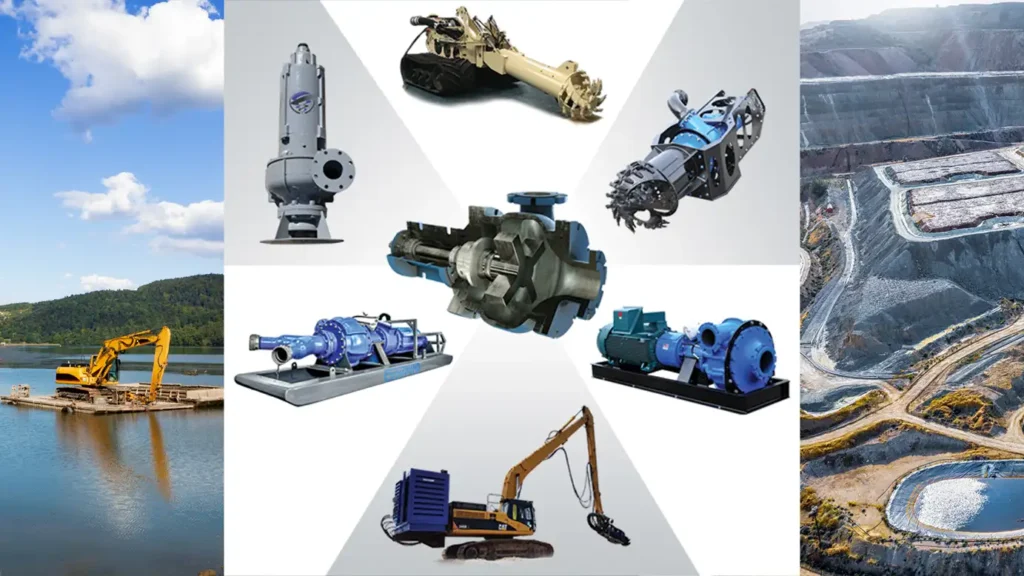Table of Contents:
- Introduction
- Why Industrial Pumps Are the Backbone of Dredging?
- Understanding Dredging Operations & Their Challenges
- Key Types of Industrial Pumps in Dredging
- How Industrial Pumps Enhance Dredging Efficiency?
- Critical Features of High-Performance Dredging Pumps
- Importance of Industrial Dredging Pump
- Future Trends in Dredging Pump Technology
- Conclusion
The Essential Role of Industrial Pumps Used in Dredging Operations
Introduction
Dredging is a crucial process across industries such as maritime, construction, mining, and environmental restoration. It involves removing sediments, debris, and other materials from the bottom of bodies of water to maintain or increase waterway depth, support infrastructure projects, or restore ecosystems. At the heart of this complex operation lies a key component: industrial pumps. These powerful machines are the driving force that makes efficient dredging possible.
Why Industrial Pumps Are the Backbone of Dredging?
Industrial pumps are integral to dredging because they transport the dredged material from the excavation site to the discharge area. Without these pumps, moving tons of sand, gravel, sludge, or silt would be inefficient or even impossible. The performance, durability, and adaptability of industrial pumps determine how smoothly and successfully a dredging operation proceeds. They help maintain operational flow, reduce manual handling, and improve overall productivity.
Understanding Dredging Operations & Their Challenges
Dredging operations can vary significantly based on purpose, location, and environmental conditions. Projects may include:
- Deepening navigation channels
- Port maintenance
- Coastal land reclamation
- Riverbed or reservoir clean-up
- Environmental remediation
These operations often occur in harsh environments and involve abrasive, corrosive, or dense materials. Challenges include equipment wear, varying sediment types, and maintaining efficiency across fluctuating water levels. Industrial pumps help tackle these challenges by offering consistent and powerful performance under demanding conditions.
Key Types of Industrial Pumps in Dredging
Several types of industrial pumps are commonly used in dredging, each designed for specific tasks and materials:
- Centrifugal Pumps: Most commonly used, they rely on rotational energy to move slurry through pipelines.
- Submersible Pumps: Operate underwater and are ideal for deep or confined spaces.
- Hydraulic Dredge Pumps: Utilize high-pressure water jets to loosen and transport materials.
- Self-Priming Pumps: Positioned above the water level and suitable for easier maintenance access.
- Slurry Pumps: Built to handle abrasive mixtures with a high solids content.
Each pump type offers unique advantages and should be chosen based on the specific requirements of the dredging site.
How Industrial Pumps Enhance Dredging Efficiency?
Industrial pumps play a crucial role in enhancing dredging efficiency by enabling continuous, high-volume sediment handling with minimal interruption. Their ability to operate consistently without frequent manual intervention allows for more material to be moved in less time, resulting in reduced fuel consumption and operational downtime. These pumps are designed to manage large volumes of sediment efficiently while minimizing blockages through optimized flow rates and robust materials handling.
Additionally, they support extended discharge distances, often eliminating the need for booster stations. Modern industrial pumps are also equipped with automated monitoring systems that track performance metrics, detect wear, and provide early warnings for maintenance, further improving reliability and reducing the risk of unexpected failures.
Critical Features of High-Performance Dredging Pumps
To withstand the rigors of dredging efficiency, industrial pumps must be robust, reliable, and easy to maintain. Key features include:
- Wear-Resistant Materials: Such as high-chrome alloys or rubber-lined interiors to resist abrasion
- High Solids Handling Capacity: To transport dense slurry without clogging
- Modular Designs: For quick part replacement and reduced downtime
- Energy-Efficient Motors: Lowering operational costs without compromising output
- Customizable Impellers: Tailored to sediment types and flow conditions
These features collectively ensure that the pumps perform reliably throughout the project lifecycle.
Importance of Industrial Dredging Pump
Industrial dredging pumps play a critical role that extends far beyond simply transporting material—they are central to the overall efficiency and success of a dredging operation. Their performance directly impacts project timelines by enabling faster material movement, which can significantly shorten completion schedules. Efficient pumps also contribute to cost management by lowering fuel consumption, reducing labor demands, and minimizing equipment wear and replacement needs.
From a safety perspective, well-functioning pumps help prevent leaks, spills, and mechanical failures, reducing operational risks. Furthermore, precise sediment handling supports environmental compliance by limiting ecological disruption and ensuring adherence to regulatory standards. Ultimately, the dredging pump is not just a piece of equipment—it is the operational cornerstone that drives productivity, safety, and sustainability throughout the project.
Future Trends in Dredging Pump Technology
The future of dredging pump technology is being shaped by the growing demand for sustainability, efficiency, and operational reliability. One key trend is the rise of smart pumps equipped with IoT sensors, enabling real-time diagnostics and predictive maintenance to minimize downtime. Eco-friendly designs are also gaining prominence, with innovations aimed at reducing emissions and enhancing energy efficiency.
In addition, the use of advanced materials such as ceramics and composite coatings is extending pump life by improving resistance to wear and abrasion. Modular system architectures are emerging as well, offering scalable solutions that enable faster deployment and adaptability to project requirements. Collectively, these developments are set to deliver greater performance, environmental compliance, and long-term value for dredging contractors.
Conclusion
Industrial pumps are indispensable to dredging operations, providing the muscle needed to move massive volumes of material efficiently and safely. From handling abrasive slurries to adapting to variable conditions, these pumps play a vital role in the success and sustainability of dredging projects. As technology advances, their role will only become more essential—driving innovations that improve performance, reduce environmental impact, and streamline complex operations.



